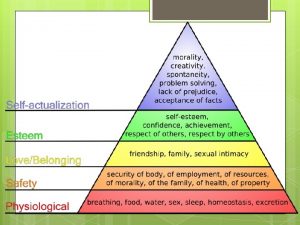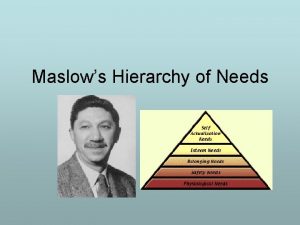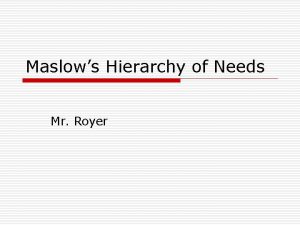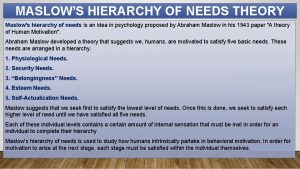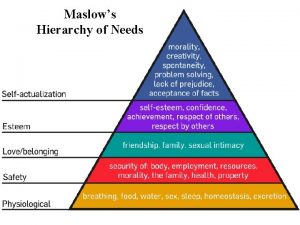MASLOW Maslows hierarchy of needs Aims l Understand










- Slides: 10

MASLOW Maslow's hierarchy of needs Aims: l Understand Maslow's hierarchy of needs l Identify criticisms l Identify situations where theory may be appropriate

HERZBERG

How does the Hierarchy Work? • A person starts at the bottom of the hierarchy (pyramid) and will initially seek to satisfy basic needs (e. g. food, shelter). Once these physiological needs have been satisfied, they are no longer a motivator. the individual moves up to the next level • Safety needs at work could include physical safety (e. g. protective clothing) as well as protection against unemployment, loss of income through sickness etc) • Social needs recognise that most people want to belong to a group. These would include the need for love and belonging (e. g. working with colleague who support you at work, teamwork, communication)

l l l Esteem needs are about being given recognition for a job well done. They reflect the fact that many people seek the esteem and respect of others. A promotion at work might achieve this Self-actualisation is about how people think about themselves - this is often measured by the extent of success and/or challenge at work Maslow's model has great potential appeal in the business world. The message is clear - if management can find out which level each employee has reached, then they can decide on suitable rewards

Problems with the Maslow Model l l There are several problems with the Maslow model when real-life working practice is considered: - Individual behaviour seems to respond to several needs - not just one - There is a problem in deciding when a level has actually been "satisfied" - The model ignores the often-observed behaviour of individuals who tolerate low-pay for the promise of future benefits - There is little empirical evidence to support the model. Some critics suggest that Maslow's model is only really relevant to understanding the behaviour of middle-class workers in the UK and the USA (where Maslow undertook his research).

Herzberg - Two Factor Theory l Herzberg analysed the job attitudes of 200 accountants and engineers who were asked to recall when they had felt positive or negative at work and the reasons why


Hygiene Factors l l l l Hygiene factors are based on the need to for a business to avoid unpleasantness at work. If these factors are considered inadequate by employees, then they can cause dissatisfaction with work. Hygiene factors include: - Company policy and administration - Wages, salaries and other financial remuneration - Quality of supervision - Quality of inter-personal relations - Working conditions - Feelings of job security

Motivator Factors l l l l Motivator factors are based on an individual's need for personal growth. When they exist, motivator factors actively create job satisfaction. If they are effective, then they can motivate an individual to achieve above-average performance and effort. Motivator factors include: - Status - Opportunity for advancement - Gaining recognition - Responsibility - Challenging / stimulating work - Sense of personal achievement & personal growth in a job

l l l According to Herzberg, management should focus on rearranging work so that motivator factors can take effect. He suggested three ways in which this could be done: - Job enlargement - Job rotation - Job enrichment
 Video on maslow's hierarchy of needs
Video on maslow's hierarchy of needs Humanistic perspective on personality
Humanistic perspective on personality The lowest level in maslow's hierarchy of needs emphasizes:
The lowest level in maslow's hierarchy of needs emphasizes: Maslow's hierarchy of needs parenting
Maslow's hierarchy of needs parenting Maslow vs erikson
Maslow vs erikson Maslow hierarchy of needs
Maslow hierarchy of needs Anglia ruskin university harvard referencing
Anglia ruskin university harvard referencing Abraham maslow developed his hierarchy of needs
Abraham maslow developed his hierarchy of needs Abraham maslow hierarchy of needs summary
Abraham maslow hierarchy of needs summary Maslow's hierarchy of needs entertainment
Maslow's hierarchy of needs entertainment Who is maslow's
Who is maslow's





